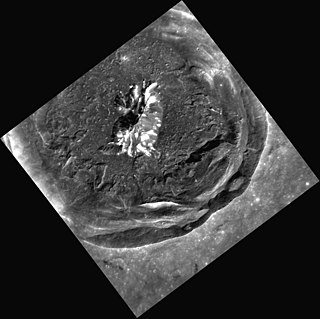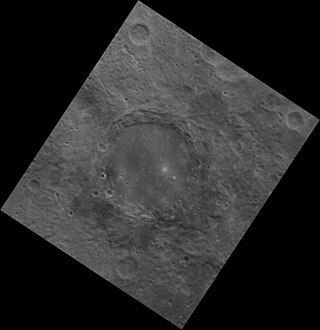
Matisse is an impact crater on the southern hemisphere of Mercury. Matisse takes its name from the French artist Henri Matisse, and it was named by the IAU in 1976.

Mozart is a crater on Mercury, named by the IAU in 1976 after Austrian composer Wolfgang Amadeus Mozart.

Eminescu is a peak ring crater on Mercury 125 kilometers (78 mi) in diameter. Since there are very few later craters superposed on it, Eminescu appears to be a young crater formed around one billion years ago. It has a transitional morphology between larger more complex impact basins like Raditladi and smaller simpler central peak craters.

Xiao Zhao crater is small in comparison with many other craters on Mercury. However, Xiao Zhao's long bright rays make it a readily visible feature. The fresh, bright rays, which were created by material ejected outward during the impact event that formed the crater, indicate that Xiao Zhao is a relatively young crater on Mercury's surface.

Atget crater is distinctive on the planet Mercury's surface due to its dark color. Atget crater is located within Caloris basin, near Apollodorus crater and Pantheon Fossae. The dark color of the floor of Atget is in contrast to other craters within Caloris basin that exhibit bright materials on their floors, such as the craters Kertész and Sander. Other craters on Mercury, such as Bashō and Neruda, have halos of dark material but the dark material does not cover the crater floors.

Cunningham is a young crater on the western floor of the Caloris Basin, on Mercury. It is surrounded by a bright ray system.

Amaral is a crater on the planet Mercury. With its smooth floor, surrounding ejecta, and small secondary craters, it appears noticeably younger than the heavily cratered surface around it. Along with a smooth crater floor, Amaral also has a central peak. Bright material on this peak is of particular interest as it appears to have an unusual color. In color-enhanced images, the central peak of Amaral appears as a bright blue color in striking contrast to the otherwise orange tones of surface material nearby. The different color of the central peak likely indicates rocks with different chemical composition from those on the neighboring surface.

Raditladi is a large impact crater on Mercury with a diameter of 263 km. Inside its peak ring there is a system of concentric extensional troughs (graben), which are rare surface features on Mercury. The floor of Raditladi is partially covered by relatively light smooth plains, which are thought to be a product of the effusive volcanism. The troughs may also have resulted from volcanic processes under the floor of Raditladi. The basin is relatively young, probably younger than one billion years, with only a few small impact craters on its floor and with well-preserved basin walls and peak-ring structure. It is one of 110 peak ring basins on Mercury.

Berkel is a crater on the planet Mercury. Its name was approved by the IAU on July 9, 2009. It was named after the modernist painter Sabri Berkel.

Alencar is a crater on Mercury. It has a diameter of 120 kilometers. Its name was adopted by the International Astronomical Union (IAU) in 1979. Alencar is named for the Brazilian novel writer José de Alencar, who lived from 1829 to 1877.

Bartók is a crater on Mercury. Its name was adopted by the International Astronomical Union (IAU) in 1979. Bartók is named for the Hungarian composer Béla Bartók, who lived from 1881 to 1945.

Bello is a crater on Mercury. It has a diameter of 129 kilometers. Its name was adopted by the International Astronomical Union (IAU) in 1976. Bello is named for the Venezuelan poet Andrés Bello, who lived from 1781 to 1865.

Han Kan is a crater on Mercury. It has a diameter of 50 kilometers. Its name was adopted by the International Astronomical Union (IAU) in 1985. Han Kan is named for the Chinese painter Han Gan, who lived from 720 to 780.

Balanchine is a crater on the planet Mercury. It possesses a ray system of slightly bluish rays. These rays inspired the name of the crater due to their similarity to the tutu in George Balanchine's Serenade.

Tyagaraja is a crater on Mercury. Its name was adopted by the International Astronomical Union in 1976. Tyagaraja is named for the Indian composer Tyagaraja.

Alver is a crater on Mercury. It has a diameter of 151.49 kilometers. Its name was adopted by the International Astronomical Union (IAU) on March 15, 2013. Alver is named for the Estonian poet Betti Alver.

Rustaveli is a crater on Mercury. Its name was adopted by the International Astronomical Union in 2012, after the Georgian poet Shota Rustaveli.

Mendelssohn is a crater on Mercury. Its name was adopted by the International Astronomical Union (IAU) on April 24, 2012. Mendelssohn is named for the German composer Jakob Ludwig Felix Mendelssohn.

Hafiz is a crater on Mercury. It has a diameter of 280 kilometres. Its name was adopted by the International Astronomical Union (IAU) on June 23, 2014. Hafiz is named for the Persian poet Hafez.

Heaney is a crater on Mercury. It has a diameter of 125 kilometres. Its name was adopted by the International Astronomical Union (IAU) on March 20, 2017. Heaney is named for the Irish poet and playwright Seamus Heaney.






















